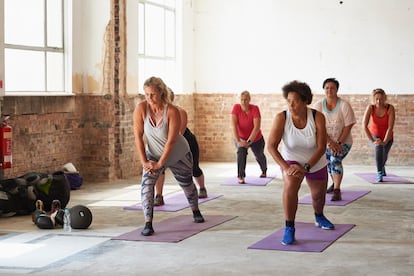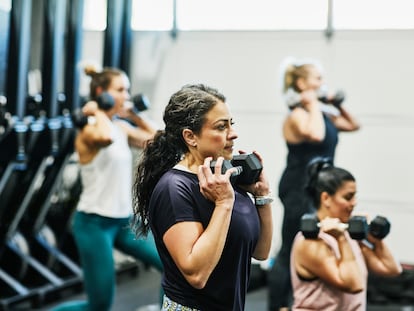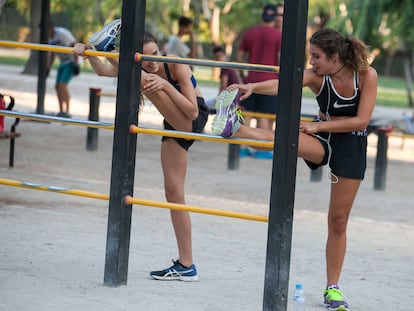One of the world’s leading exercise experts explains how to move your body better and more often
Gray Cook, the author of the book ‘The Business of Movement: Principles, Patterns, and Productivity,’ notes that ‘moving well’ means being able to painlessly perform daily activities for both leisure and work

Many people think that the exercises they perform in a training room are an end in themselves, but in reality they are a means to do activities in our daily lives. Climbing a staircase, getting up from a chair, picking up an object that falls on the floor, carrying shopping bags, walking any distance necessary to visit a city, running after a bus... All these activities involve movement. But what happens when our body limits our ability to perform these activities?
Moving well could be the key to avoiding the onset of aches and pains. Studies show that the risk of injury can increase with poor-quality movement patterns, poor flexibility and previous injuries. Gray Cook, the author of the book The Business of Movement: Principles, Patterns, and Productivity and co-founder of Functional Movement Systems (FMS), is a physical therapist and one of the world’s leading experts on exercise.
Ability and freedom
“For me, moving well is first and foremost about being able to perform my daily activities of daily living, leisure and work without [feeling any] pain. I don’t expect that they can always be done comfortably, because sometimes we train to exhaustion and can get stuck in certain positions for longer than we’d like. But for the most part, you should be able to get through the day pain-free by getting into a certain position or doing a certain movement pattern,” Cook says. “Secondly, you should have the freedom and comfort to do most things in different ways,” he adds.
The biomechanics specialist talks about the importance of understanding that human behaviors have predictable patterns. “They lead us to good or bad places. Moving well is about avoiding [the latter], being aware and protecting yourself, [and] when you encounter them, realizing it and correcting yourself. They have as much to do with behavior modification as they do with the products and services you might buy or consume,” he observes.
Given that this is the case, the question is: Why would we move badly? The way we breathe, sleep, eat, the way we adopt unfavorable habits are what the expert calls “myopic or one-sided” activities. To put it in dietary terms, that would be like eating the same two vegetables for a lifetime instead of discovering the benefits of a variety of them. We overtrain or undertrain. We overwork or underwork. “We over-recover or under-recover,” Cook comments. He adds that the first thing we should do to give ourselves the opportunity to move correctly is “not destroy our natural cycles, that is, the things that happen set by our clock such as breathing rate, the way we consume energy, rest and recover; the way we handle training loads and patterns and positions.”
Only by knowing the hand you are dealt can you play it in the best way possible. The impetus to start training or lack of knowledge can often lead users to start building the house from the roof down, use shortcuts and avoid taking the time to build a good foundation to support its construction. Movement assessment is that foundation, the starting point for knowing how you move; from there, you can begin to make a plan to move better. As Cook advises, “Don’t assume you need exercise and don’t assume you have a medical problem. Let an assessment based on data and years of experience tell you what your weakest point is, because working on any other part of movement may not be the best choice for your focus and effort.”
Pain
Imagine you go to carry your backpack to work and you feel discomfort in your spine. Pain can condition movement disorders. As Cook explains, “There are two types of motion that can easily do damage: normal motion in a faulty structure (such as a fracture or ligament sprain) and excessive motion in a normal structure (which could be speed, impact, range or torque). Acute pain prevents you from moving in such a way that you might cause more harm to yourself. But chronic pain can be a distorted signal that is amplified or suppressed and should be investigated, because it is rooted in the movement behavior itself.”
Cook’s team realized that pain can dictate and alter movement behavior, both as a subconscious messenger and as a conscious thought switch. Thus, the specialist notes, “we must take pain off the table and never answer questions about exercise or therapy without a complete evaluation as to the source, area and associated dysfunctions. This will allow us to perform a risk factor assessment to demonstrate all the things that the patient or athlete could do better in their self-care, when it comes to facilitating the rehabilitation process and eliminating the risk of future relapse that obviously exists at this stage.”
Exercises
In the gym, you can see many amazing exercises, but when it comes to training, which of them would help you move better? “In simple terms, any exercise that allows you to get up and down to the floor in a smoother, easier, more organized way, with more options and [greater] ease would be good,” the expert says. Most people try to run, climb, swim, lift things, throw or kick things better. But if that pursuit makes it slower for them to get up and down on the ground; it reduces their options for doing so and it means they’ve given up function in favor of skill. In fact, function is the basis for skill. As Cook explains, “Maintaining efficient, functional skill feeds consistency, and this in turn reinforces motor learning. So, we must maintain function. Those functional changes in position that get us up and down to the ground are the backbone of knowledge in functional movement assessment.”
Stability first
Are you able to bend all the way down to pick up a pen without falling to the floor afterward? According to Cook, mobility comes first. Stability comes second. And movement patterns come third. “That’s how it happens in neurodevelopment and that’s how we need to reorganize the system. But that doesn’t mean that we should start every workout with stretching: [it] simply [means] that mobility represents freedom of movement. If that is not possible, we would be facing a ‘mobility problem,’ even if a good night’s rest, a massage or stretching improves it. Lack of freedom is a mobility problem. If freedom is good, but movement is bad, then we must assume it is a stability or control problem.
The environment can push you toward a sedentary lifestyle and the attendant risks, including joint pain; many jobs now require long days sitting in a chair in front of a computer. Stopping that trend would involve knowing what your movement is like, assessing it and increasing it. Human beings are designed to jump, run, squat and stand up, not spend eight or ten hours sitting down. Movement is life.
From theory to practice
- Get to know yourself. A pre-assessment of movement by a qualified professional will help you understand what the problem is and guide your work to most productively increase, maintain and sustain good movement, regardless of your problem and rate of improvement. Randomly undertaking an exercise program without knowing the findings of your movement assessment will just waste time and limit results.
- Warming up is crucial. As Gray Cook explains, “It’s important to warm up before training, because if someone could improve their state of readiness by one or two percent, that could mean the difference between a good workout and a bad workout, between an excellent workout day or an average one, between an average competition or an excellent one.” So, readiness matters, whether we’re training, having a normal day or competing. But you should review your warm-up to see if it actually improves your readiness. Your state of readiness improves the ease with which you go into and out of positions and postures. It also improves your balance in general, because you are getting your body to organize its signals, reception system and movement response in a more refined way.
- See how the best ones do it. Gray Cook has posted three different movement warm-ups on YouTube that he calls flows. One targets mobility, hips, ankles and upper back, where the most common mobility problems occur.
Sign up for our weekly newsletter to get more English-language news coverage from EL PAÍS USA Edition
Tu suscripción se está usando en otro dispositivo
¿Quieres añadir otro usuario a tu suscripción?
Si continúas leyendo en este dispositivo, no se podrá leer en el otro.
FlechaTu suscripción se está usando en otro dispositivo y solo puedes acceder a EL PAÍS desde un dispositivo a la vez.
Si quieres compartir tu cuenta, cambia tu suscripción a la modalidad Premium, así podrás añadir otro usuario. Cada uno accederá con su propia cuenta de email, lo que os permitirá personalizar vuestra experiencia en EL PAÍS.
¿Tienes una suscripción de empresa? Accede aquí para contratar más cuentas.
En el caso de no saber quién está usando tu cuenta, te recomendamos cambiar tu contraseña aquí.
Si decides continuar compartiendo tu cuenta, este mensaje se mostrará en tu dispositivo y en el de la otra persona que está usando tu cuenta de forma indefinida, afectando a tu experiencia de lectura. Puedes consultar aquí los términos y condiciones de la suscripción digital.
More information
Últimas noticias
More than 40 Democratic lawmakers urge Trump in a letter to stop his ‘attempts to undermine democracy in Brazil’
The journal ‘Science’ criticizes Trump’s anti-renewable energy policy: ‘The US is failing to benefit from its own innovations’
Cubans hope for a miracle as dengue and chikungunya spread
The long shadow of the father figure in the films of Rob Reiner
Most viewed
- Christian Louboutin: ‘Young people don’t want to be like their parents. And if their parents wear sneakers, they’re going to look for something else’
- Cartels in Mexico take a leap forward with narco-drones: ‘It is criminal groups that are leading the innovation race’
- ‘El Limones’ and the growing union disguise of Mexican organized crime
- Liset Menéndez de la Prida, neuroscientist: ‘It’s not normal to constantly seek pleasure; it’s important to be bored, to be calm’
- The low-cost creative revolution: How technology is making art accessible to everyone











































